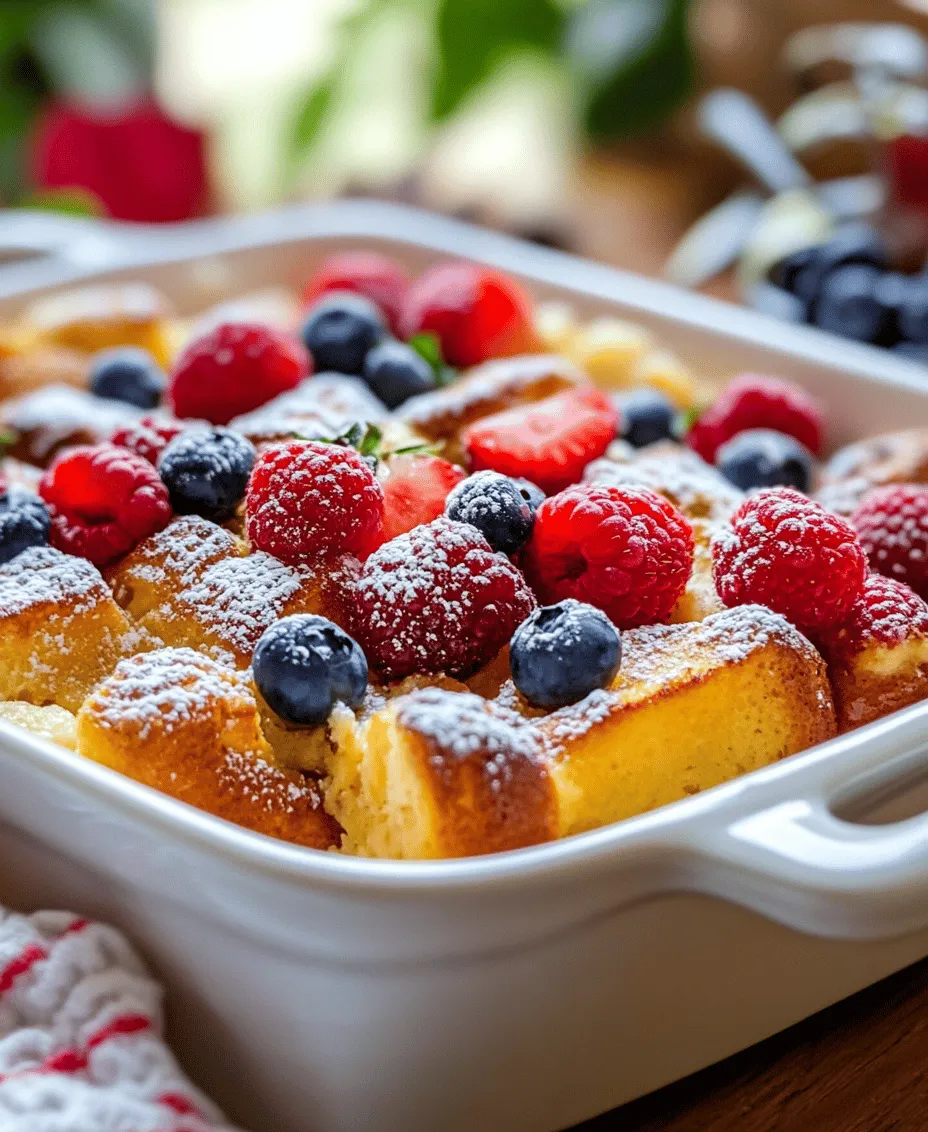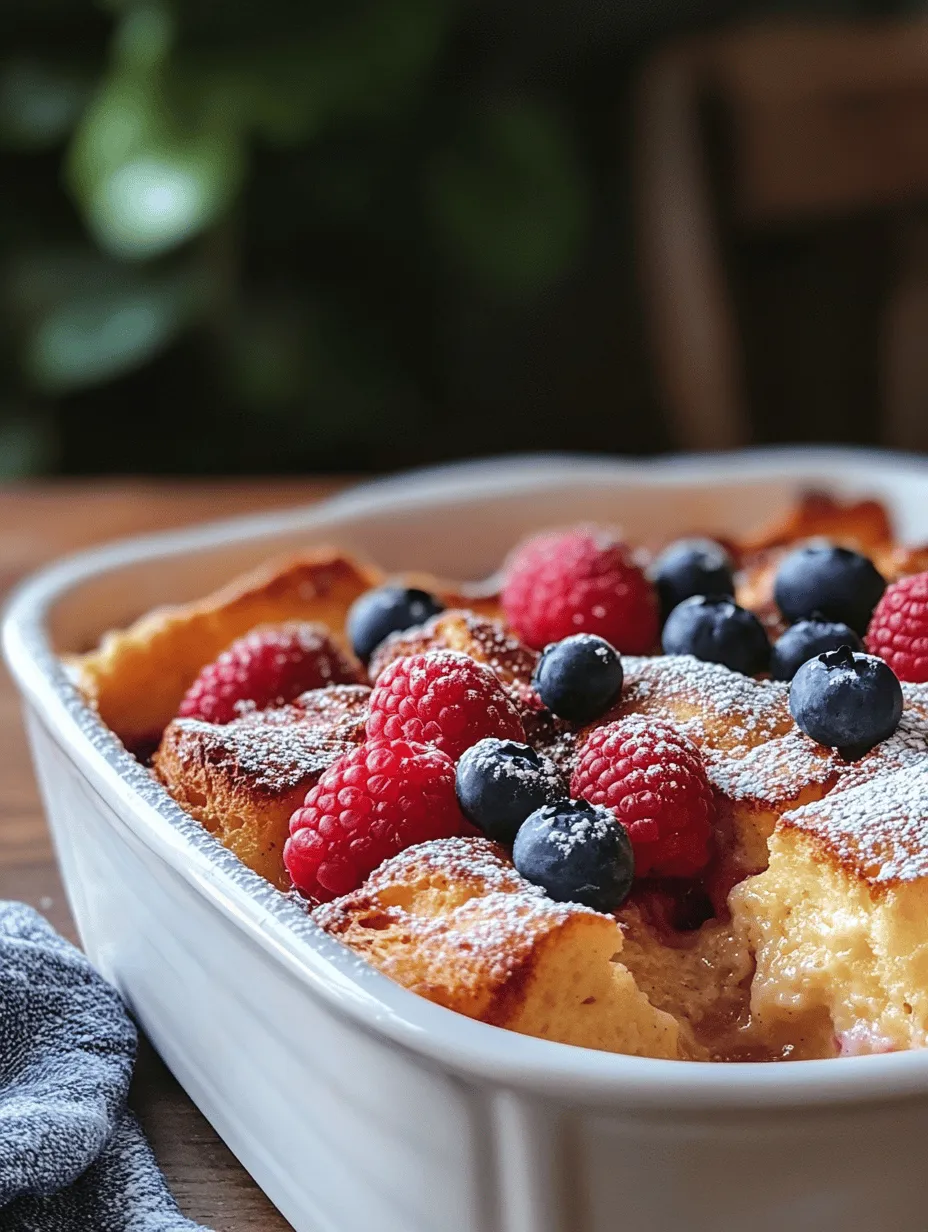Introduction
French toast has long been a beloved breakfast staple, renowned for its warm, comforting flavors that evoke feelings of nostalgia and home. Whether enjoyed on a lazy Sunday morning or served at a festive brunch, this dish has a special place in the hearts of many. However, preparing traditional French toast can be time-consuming, especially when feeding a crowd. Enter the overnight French toast casserole—a game-changer for busy families and brunch enthusiasts alike.
This delightful dish combines the classic elements of French toast into a convenient casserole form, allowing you to prepare it the night before and simply bake it in the morning. Imagine waking up to the mouthwatering aroma of cinnamon and vanilla wafting through your kitchen, without the hassle of standing over a skillet to flip individual slices. The overnight French toast casserole not only saves time but also makes for an impressive centerpiece at any gathering, be it a holiday feast, family reunion, or casual brunch with friends.
The versatility of this recipe is one of its greatest appeals. You can customize it to suit various tastes and dietary preferences, incorporating different fruits, spices, and even toppings. Whether you prefer a classic rendition with maple syrup and powdered sugar or a more adventurous twist with chocolate chips and berries, this casserole can be adapted to fit the occasion. Let’s dive deeper into the world of overnight French toast casserole and discover how to make this delicious breakfast delight.
Understanding the Basics of French Toast Casserole
At its core, a French toast casserole is a baked dish that combines cubes or slices of bread soaked in a rich custard made from eggs and milk. The result is a fluffy, custardy interior encased in a golden, slightly crisp exterior. This dish is often flavored with sweet spices like cinnamon and nutmeg, giving it that quintessential French toast flavor.
The origins of French toast can be traced back to ancient times, with various cultures creating their versions of bread soaked in a mixture of milk and eggs and then fried. However, the transition to casserole form represents a more modern adaptation, allowing for easier preparation and serving. Instead of frying each slice individually, the casserole method involves layering the bread in a dish, pouring the custard over it, and allowing it to soak overnight. This not only enhances the flavor but also allows the bread to absorb the custard fully, creating a harmonious blend of textures and tastes.
When comparing traditional French toast to its casserole counterpart, the key difference lies in the cooking method and presentation. Traditional French toast is often served as individual slices, while the casserole presents a visually appealing, family-style dish that can be sliced and served from the baking dish. This makes it an ideal choice for entertaining, as it simplifies the serving process and encourages sharing.
Key Ingredients and Their Importance
Overview of Essential Ingredients
To create a delicious overnight French toast casserole, you’ll need a handful of key ingredients that work together to create the perfect blend of flavors and textures. Here’s a breakdown of what you’ll need:
1. Bread: The foundation of your casserole. Choose a high-quality bread that will soak up the custard without falling apart.
2. Eggs: Essential for binding the ingredients and adding richness.
3. Dairy: Whole milk and heavy cream provide creaminess and depth of flavor.
4. Sweeteners: Granulated sugar and maple syrup add sweetness and enhance the overall taste.
5. Spices: Cinnamon, nutmeg, and salt contribute warmth and complexity to the dish.
6. Fresh Berries: Optional but highly recommended for a burst of freshness and color.
Brioche or Challah Bread
The choice of bread is critical when it comes to making a French toast casserole. Brioche and challah are two popular options that stand out due to their rich, buttery flavors and soft, airy textures. Brioche, with its slightly sweet taste and fluffy crumb, absorbs custard beautifully, resulting in a delightfully soft and moist casserole. Challah, a traditional Jewish bread, is also a great choice due to its slightly sweet flavor and rich, eggy texture. Both types of bread will elevate your casserole and ensure a delightful eating experience.
If you’re looking for a lighter alternative or have dietary restrictions, you can experiment with whole grain or gluten-free breads. Just keep in mind that the texture and flavor may differ slightly, so choose a bread that you enjoy.
Eggs
Eggs play a crucial role in French toast casseroles, providing structure and richness. They help bind the bread and custard mixture together, ensuring that each bite is cohesive. When selecting eggs, opt for large eggs, as this is the standard size used in most recipes. The quality of eggs can also affect the flavor of your dish, so consider using organic or free-range eggs if possible.
Dairy Components (Whole Milk and Heavy Cream)
Whole milk and heavy cream are key players in achieving a rich and creamy custard. Whole milk adds moisture and a subtle creaminess, while heavy cream contributes to a luscious texture that makes the casserole indulgent. You can adjust the ratio of milk to cream based on your personal preference for richness. For a lighter version, consider using lower-fat milk or a dairy-free alternative, such as almond milk or oat milk, although this may slightly alter the final texture.
Sweeteners (Granulated Sugar and Maple Syrup)
Finding the right balance of sweetness is essential for the perfect overnight French toast casserole. Granulated sugar is typically used to sweeten the custard, while maple syrup adds an authentic flavor that pairs perfectly with the spices. When baking, you can adjust the amount of sugar based on your taste or dietary needs. For a healthier alternative, consider using natural sweeteners like honey or agave syrup.
Spices (Cinnamon, Nutmeg, and Salt)
The warm spices of cinnamon and nutmeg are what truly elevate the flavor profile of your French toast casserole. Cinnamon adds a cozy warmth, while nutmeg introduces a subtle, aromatic note. A pinch of salt is also essential, as it helps balance the sweetness and enhances the overall flavor of the dish. Feel free to adjust the spice levels according to your preference, but be careful not to overpower the delicate balance of flavors.
Fresh Berries
Adding fresh berries not only enhances the visual appeal of your casserole but also provides a burst of freshness and nutritional benefits. Blueberries, strawberries, and raspberries are popular choices, but you can mix and match based on what’s in season or your personal preference. The berries can be folded into the casserole before baking or sprinkled on top once it’s done. Either way, their vibrant colors and natural sweetness will make your dish even more enticing.
Ingredient Substitutions for Dietary Restrictions
One of the many advantages of the overnight French toast casserole is its adaptability. If you or your guests have dietary restrictions, there are plenty of substitutions you can make without sacrificing flavor:
– Gluten-Free Options: Use gluten-free bread varieties, which are widely available and often just as delicious.
– Dairy-Free Alternatives: Substitute whole milk and heavy cream with almond milk, coconut milk, or any other plant-based milk. You can also use dairy-free cream cheese for added richness.
– Egg Substitutes: For a vegan version, consider using flax eggs or a commercial egg replacer to maintain the binding properties of eggs.
– Lower Sugar Options: Substitute granulated sugar with natural sweeteners or sugar alternatives like stevia or monk fruit.
By adjusting the ingredients to cater to specific dietary needs, you can ensure that everyone can enjoy this delectable dish.
Step-by-Step Guide to Making Overnight French Toast Casserole
Preparation of the Bread
The first step in crafting the perfect overnight French toast casserole is to prepare the bread. The way you cut and prepare the bread significantly impacts how well it absorbs the custard and the overall texture of the casserole.
1. Choose Your Bread: As mentioned earlier, brioche or challah are ideal choices for this recipe. If you’re using a loaf, ensure it’s a day or two old. Stale bread holds up better in the custard, preventing it from becoming soggy.
2. Cutting the Bread: Start by slicing the bread into cubes of approximately 1-inch in size. This size is perfect for allowing the custard to soak in while still maintaining some structure during baking. If you prefer a more rustic look, you can also tear the bread into pieces rather than cutting it.
3. Arranging the Bread: Place the bread cubes in a greased 9×13-inch baking dish, arranging them evenly. If you’d like to enhance the flavors further, consider layering in some fresh berries or chocolate chips among the bread pieces for added texture and sweetness.
4. Soaking the Bread: Once your bread is arranged, it’s time to make the custard. In a separate mixing bowl, whisk together your eggs, milk, cream, sugar, and spices until well combined. Pour the custard mixture evenly over the bread cubes, making sure every piece is coated. You can gently press down on the bread to ensure it absorbs the custard fully.
5. Chill Overnight: Cover the baking dish with plastic wrap and refrigerate it overnight. This step is crucial, as it allows the bread to soak up the custard thoroughly, resulting in a creamy and flavorful casserole when baked.
By following these initial steps, you’re well on your way to creating a delightful overnight French toast casserole that will impress your family and friends. Stay tuned for the next section, where we will dive into the baking process and a few extra tips to ensure your casserole comes out perfectly every time.

Creating the Custard
To create the custard for your Overnight French Toast Casserole, you’ll need to combine eggs, milk, cream, vanilla extract, and a hint of cinnamon. This rich custard is the heart of the dish, infusing the bread with flavors and creating that deliciously soft texture everyone loves.
Tips on Whisking Techniques for a Smooth, Lump-Free Mixture
Whisking is crucial for achieving a smooth custard. Here are some effective techniques to ensure your mixture is lump-free:
1. Room Temperature Ingredients: Start with room temperature eggs and milk. Cold ingredients can lead to clumping, so let them sit out for about 30 minutes before beginning.
2. Whisking Method: Use a whisk rather than a fork, as it incorporates air and breaks up any lumps more effectively. Start by whisking the eggs alone until they are frothy, then slowly add in the milk and cream while continuing to whisk.
3. Incorporate Dry Ingredients Gradually: If you’re adding cinnamon or sugar, mix these dry ingredients in a separate bowl first and then add them slowly to the egg mixture while whisking continuously. This helps avoid clumps.
4. Sift Your Dry Ingredients: If you’re using powdered or granulated sugar, sifting before adding can help eliminate any lumps, ensuring a smooth custard.
Assembling the Casserole
Once your custard is smooth, it’s time to assemble your casserole.
Best Practices for Evenly Distributing the Custard and Toppings
1. Layering Bread: Start by layering your bread cubes evenly in your baking dish. This will help to ensure that every piece of bread is soaked in the custard.
2. Pour the Custard: Gently pour the custard over the bread. Take your time to ensure it seeps into all the crevices. You can use a spatula to gently push the bread down if necessary.
3. Adding Toppings: If you’re using any toppings, such as berries or nuts, sprinkle them evenly across the top before pressing down. This ensures that they are incorporated into the casserole rather than sitting on top.
Importance of Pressing the Bread Down to Ensure Thorough Soaking
To ensure every piece of bread absorbs the custard, gently press the bread down after pouring on the custard. This helps eliminate any dry spots and guarantees a uniform texture throughout the casserole. You can cover the dish with plastic wrap and let it sit for a few minutes to allow the bread to soak up the custard effectively.
Refrigeration
Now that your casserole is assembled, it’s time for the refrigeration phase.
The Science Behind Overnight Soaking and How It Enhances Flavor and Texture
Refrigerating the casserole overnight is a game-changer. This soaking time allows the bread to absorb the custard fully, resulting in a richer flavor and a more satisfying texture. The sugars in the bread caramelize during baking, and the custard flavors meld with the bread, enhancing the overall taste. Additionally, the moisture from the custard ensures that the bread doesn’t dry out during baking, leading to a perfect balance of softness and slight crispness on the top.
Baking
After your casserole has soaked overnight, it’s time to bake.
Instructions for Achieving the Perfect Bake: Temperature, Time, and Visual Cues
1. Preheat the Oven: Preheat your oven to 350°F (175°C). This is the ideal temperature for cooking the casserole evenly without burning the top.
2. Bake Time: Place your casserole in the preheated oven and bake for 45-50 minutes. Keep an eye on it; you’re looking for a golden-brown top that has puffed up slightly.
3. Visual Cues: To check for doneness, you can insert a knife into the center of the casserole. If it comes out clean or with just a few crumbs, your casserole is done. The surface should be set, and the edges slightly crisp.
4. Cooling: Let the casserole sit for about 10-15 minutes before serving. This allows it to firm up a bit, making it easier to cut and serve.
Serving Suggestions and Pairings
When it comes to serving your Overnight French Toast Casserole, presentation can elevate the dining experience.
Presentation Ideas for Serving the Casserole
1. Slice and Serve: Slice the casserole into squares or rectangles and serve them on individual plates. This makes it easy for guests to enjoy.
2. Add Color: Garnish the plate with fresh berries or a sprinkle of powdered sugar for a pop of color. A drizzle of maple syrup can also enhance the visual appeal.
Discussion on Garnishes: Powdered Sugar, Extra Berries, and Maple Syrup
For garnishes, consider these options:
– Powdered Sugar: A light dusting of powdered sugar adds a touch of sweetness and an elegant look.
– Extra Berries: Fresh strawberries, blueberries, or raspberries can be scattered on top or served on the side for a refreshing addition.
– Maple Syrup: Provide a small pitcher of warm maple syrup for drizzling, enhancing the sweet flavor of the dish.
Suggested Beverage Pairings
Pair your casserole with:
– Coffee: A strong cup of coffee complements the sweetness of the casserole perfectly.
– Tea: Choose a herbal or chai tea for a cozy touch.
– Juices: Freshly squeezed orange juice or apple juice can provide a refreshing contrast to the rich flavors of the casserole.
Variations to Consider: Adding Nuts, Chocolate Chips, or Different Fruits
To customize your Overnight French Toast Casserole, consider these delicious variations:
– Nuts: Chopped walnuts or pecans can add a delightful crunch and nutty flavor.
– Chocolate Chips: For a sweeter twist, fold in some semi-sweet chocolate chips into the bread mixture.
– Different Fruits: Experiment with seasonal fruits like apples, bananas, or peaches for a unique flavor profile.
Nutritional Information and Health Considerations
Understanding the nutritional profile of your Overnight French Toast Casserole can help you make informed choices.
Overview of the Nutritional Profile Per Serving
Typically, one serving of this casserole (about 1/8 of the entire dish) contains approximately:
– Calories: 350-400
– Protein: 10-12 grams
– Carbohydrates: 50-55 grams
– Fat: 15-20 grams
– Sugar: 10-15 grams
Consideration of Calories, Sugar Content, and Macronutrients
While this casserole is a delicious treat, it’s essential to be mindful of its caloric and sugar content. The combination of eggs and milk provides protein and healthy fats, while the bread contributes carbohydrates. You can reduce the sugar by using less sweetener or opting for whole grain bread for added fiber.
Discussion on How to Enjoy the Dish as Part of a Balanced Breakfast
To enjoy this dish as part of a balanced breakfast, consider serving it with a side of fresh fruit or a small serving of yogurt. This can add fiber and probiotics, making your breakfast more nutritious without sacrificing flavor.
Conclusion
The Overnight French Toast Casserole is an easy and delightful dish that promises to impress your family and friends. With its rich custard and the ability to customize with various fruits and toppings, it’s perfect for special occasions or any morning when you want a stress-free breakfast.
This recipe not only saves time during the busy morning rush but also delivers a comforting and delicious meal that everyone will love. Its versatility allows for endless variations, so feel free to experiment with different flavors and ingredients to suit your taste.
Try making this casserole the night before your next brunch or holiday gathering, and watch as it becomes a beloved staple in your breakfast rotation. Enjoy the ease and joy of serving a dish that is both satisfying and delicious, bringing warmth and happiness to your table.



